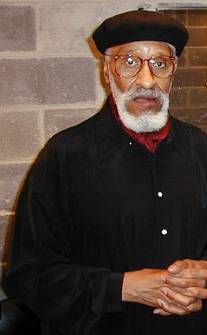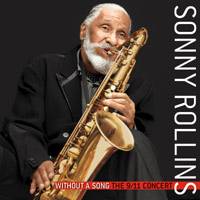
NOVEMBER 2005
Sonny Rollins's Newsletter


Sonny is busy preparing for a tour of Japan, from October 31st to November 11th. He played at Tanglewood and the Monterey Festival in September, as well as gigs in Ann Arbor and Madison, this fall.
Contact Information email: webmaster@sonnyrollins.com web: http://www.sonnyrollins.com
![]()
 Sonny's
new CD, “Without A Song: The 9/11 Concert,” was
released by Milestone Records the week before his 75th
birthday on September 7th.
Sonny's
new CD, “Without A Song: The 9/11 Concert,” was
released by Milestone Records the week before his 75th
birthday on September 7th.
Not surprisingly, Sonny has done scores of interviews the past few months, including his first ever, Podcast.
Audio
Part One of the Extended Audio interview with Sonny where he discusses his philosophy of life and his 9/11 experience.
Video
In a clip from “Saxophone Collossus,” Sonny offers his thoughts on practicing and preparing for a performance.
Check out the new
Media Gallery content

*******Lazaro
Vega jazz director at Blue Lake Public Radio, review:.
Sonny Rollins at
Hill Auditorium, Ann Arbor, October 1, 2005
Picking his spots
Sonny Rollins appearance in Ann Arbor Saturday night
unfurled in a careful arc of energy, one allowing the 75
year old musician to maintain the level of quality he's
exemplified in nearly 60 years of making music and still
reach the heights of physicality his type of spontaneous
expression demands. So while the apex of Saturday's
performance came during a nearly fifteen minute solo on
"Don't Stop the Carnival," the kind of high
energy, overflowing blowing he used to do for 50 minutes
or longer, there was no diminution in the quality of the
music. His ideas are abundant, his sound supreme and his
wisdom profound. The "sides" of the arc up to
and falling away from that apex were highlighted by
Rollins' musical interplay with guest drummer Al Foster,
and long, long solos by electric guitarist Bobby Broom
and the beautiful sounding trombonist Clifton Anderson.
It was clear during the opening number "Biji"
as his sidemen soloed at length on the lilting original,
and the on second number "I Want To Talk About
You" that at this stage of his career the tenor
saxophone master is picking his spots: he conserves his
energy by concentrating on sound, melodic interplay and
leading his band before he'll cut loose with tumultuous
improvisations as in days of youth . And whenever he did
step front and center his band fell into place with him
-- they all rallied around his sound with a cohesion the
members don't always display on their own.
With Bob Cranshaw playing minimal notes on electric bass
and Al Foster playing in that free-funk bag people might
recall from his time with Miles Davis the rhythm section
took on a later electric Miles Davis flavor. Clifton
Anderson's lion share of solo space on "Biji"
showed off his warm sound, flexibility (his ability to
jump the same wide intervals as Rollins is prerequisite)
and good melodic sense. In fact he may have even saved
the boss on the bridge the first time through "I
Want To Talk About You."
The choice of "I Want to Talk About You" with
it's ravishing melody, "They Say It's
Wonderful" with it's tender romance, "A
Nightingale Sang in Berkeley Square" with it's minor
tendency and "Why Was I Born?" featuring an
unaccompanied, cadenza-like section amounted to a great
program from which Rollins shared his sound and free
melodic concept. Just hearing how Rollins plays heads is
a lesson in possibilities: of playing off the time,
tossing counter melodies against the trombone,
improvising within the melody (and hanging the question,
"Will this phrase ultimately fit?") or joining
in unison for a mellow blend with the trombone. Those
great songs gave Rollins' sound and melodic abilities a
sparkling showcase.
And though he didn't step up to his full capacity until
the third number, the direct interplay Rollins developed
with Foster on "I Want to Talk About You" was
highly musical. Rollins sticking to a riff and Foster
improvising around it could have devolved into a game of
musical patty cake -- too cute -- but didn't. They made
for an extended section of spontaneous interplay that is
jazz at its musical best. Later in the concert when they
revisited that direct interplay it was Foster who held
the riffs and Rollins who improvised around them. Both of
those moments were high points in the ensemble's
contribution.
While staccato rhythms inspired by his calypso-based
compositions have become the centerpiece of Rollins solo
style, of his most inspired moments of improvisation,
Saturday night's concert showed, too, how at 75 bebop
still lurks just beneath the surface of his music -- dig
the quote of "Wee" or "Allen's Alley"
laying perfectly in the rhythmic motion of his
"Don't Stop the Carnival" solo, or other
Birdlike asides that would flit by. The great swirls of
free associated sound he created in the mid-60's would
race in at the conclusion of a knotty, complex high speed
run, or bridge choruses; not to mention the "walking
the bar" tradition of the tenor which he used to
wake up the audience by pointing the bell right into the
front row and blasting out dark basketball sized low
notes. And quotes. Rollins even worked in "Santa
Claus Is Coming To Town" at one moment. Knocked
everyone out.
The Hill Auditorium crowd was with him every step of the
way from the opening standing ovation to greet him on
stage to the end of the second encore which closed with
an emotional quote of "St. Thomas."
Rollins signaled the entire concert was dedicated to the
great tradition of jazz in Detroit, naming Tommy Flanagan
and "the Jones brothers" specifically.
Rollins at 75 has even more to say as a musician than
Rollins at 25. And though his sound may have deepened
with an oboe-like darkness it is still voluminous as ever
and a captivating vehicle for superior spontaneous
melodic improviser he's always been.
Lazaro Vega is jazz director at Blue Lake Public Radio.